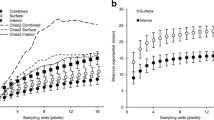Abstract
A survey of the abundances of species that inhabit the water-bearing leaves of the pitcher plant Sarracenia purpurea was conducted at several different spatial scales in northern Florida. Individual leaves are hosts to communities of inquiline species, including mosquitoes, midges, mites, copepods, cladocerans, and a diverse bacterial assemblage. Inquiline communities were quantified from four pitchers per plant, three plants per subpopulation, two subpopulations per population, and three populations. Species varied in abundance at different spatial scales. Variation in the abundances of mosquitoes and copepods was not significantly associated with any spatial scale. Midges varied in abundance at the level of populations; one population contained significantly more midges than the other two. Cladocerans varied at the level of the subpopulation, whereas mites varied at the level of the individual plants. Bacterial communities were described by means of Biolog plates, which quantify the types of carbon media used by the bacteria in each pitcher. Bacterial communities were found to vary significantly in composition among individual plants but not among populations or subpopulations. These results suggest that independent factors determining the abundances of individual species are important in determining community patterns in pitcher-plant inquilines.
Similar content being viewed by others

References
Addicott JF (1974) Predation and prey community structure: an experimental study of the effect of mosquito larvae on the protozoan communities of pitcher plants. Ecology 55:475–492
Beaver RA (1985) Geographical variation in food web structure in Nepenthes pitcher plants. Ecol Entomol 10:241–248
Biolog (1993) Instructions for use of the Biolog GP and GN microplates. Biolog, Hayward, California
Bradshaw WE (1983) Interaction between the mosquito Wyeomyia smithii, the midge Metriocnemus knabi, and their carnivorous host Sarracenia purpurea. In: Frank JH, Lounibos LP (eds) Phytolelmata: terrestrial plants as hosts for aquatic insect communities. Plexus, Medford, pp 161–189
Bradshaw WE, Creelman RA (1984) Mutualism between the carnivorous purple pitcher plant and its inhabitants. Am Midl Nat 112:294–304
Bradshaw WE, Holzapfel CM (1990) Evolution of phenology and demography in the pitcher-plant mosquito, Wyeomyia smithii. In: Gilbert F (ed) Insect life cycles: genetics, evolution, and co-ordination. Springer, Berlin Heidelberg New York, pp 47–67
Cornell HV, Lawton JH (1992) Species interactions, local and regional processes, and limits to the richness of ecological communities: a theoretical perspective. J Anim Ecol 61:1–12
Cresswell JE (1993) The morphological correlates of prey capture and resource parasitism in pitchers of the carnivorous plant Sarracenia purpurea. Am Midl Nat 129:35–41
Farkas ML, Brust RA (1985) The effect of a larval diet supplement of development in the mosquito Wyeomyia smithii (Coq) under field conditions. Can J Zool 63:2110–2113
Fashing NJ, O'Connor BM (1984) Sarraceniopus—a new genus for histiostomatid mites inhabiting the pitchers of the Sarraceniaceae (Astigmata: Histiostomatidae). Int J Acarol 10:217–227
Fish D, Hall DW (1978) Succession and stratification of aquatic insects inhabiting the leaves of the insectivorous pitcher plant, Sarracenia purpurea. Am Midl Nat 99:172–183
Garland JL, Mills AL (1991) Classification and characterization of heterotrophic microbial communities on the basis of patterns of community-level sole-carbon source utilization. Appl Environ Microbiol 57:2351–2359
Givnish TJ (1989) Ecology and evolution of carnivorous plants. In: Abrahamson WG (ed) Plant-animal interactions. McGraw-Hill, New York, pp 243–290
Hanski I, Gilpin M (1991) Metapopulation dynamics: brief history and conceptual domain. Biol J Linn Soc 42:3–16
Heard SB (1994a) Imperfect oviposition decisions by the pitcher plant mosquito (Wyeomyia smithii). Evol Ecol 8:493–502
Heard SB (1994b) Pitcher-plant midges and mosquitoes: a processing chain commensalism. Ecology 75:1647–1660
Heard SB (1994c) Wind exposure and distribution of pitcher plant mosquito (Diptera: Culicidae). Environ Entomol 23:1250–1253
Miller TE, Cassill D, Johnson C, Kindell C, Leips J, McInnes D, Bevis T, Mehlman D, Richard B (1994) Intraspecific and interspecific competition of Wyeomyia smithii (Coq) (Culicidae) in pitcher plant communities. Am Midl Nat 131:136–145
Moeur JE, Istock CA (1980) Ecology and evolution of the pitcher-plant mosquito. IV. Larval influence over adult reproductive performance and longevity. J Anim Ecol 49:775–792
Paine RT, Levin SA (1981) Intertidal landscapes: disturbance and the dynamics of pattern. Ecol Monogr 51:145–178
Pennak RW (1989) Freshwater invertebrates of the United States: Protozoa to Mollusca, 3rd edn. Wiley, New York
Pielou EC (1984) The interpretation of ecological data: a primer on classification and ordination. Wiley, New York
Ricklefs RE, Schluter D (1993a) Species diversity: an introduction to the problem. In: Ricklefs RE, Schluter D (eds) Species diversity in ecological communities: historical and geographical perspectives. University of Chicago Press, Chicago, pp 1–10
Ricklefs RE, Schluter D (eds) (1993b) Species diversity in ecological communities: historical and geographical perspectives. University of Chicago Press, Chicago
Robertson GP, Freckman DW (1995) The spatial distribution of nematode trophic groups across a cultivated ecosystem. Ecology 76:1425–1432
Robertson GP, Huston MA, Evans FC, Tiedje JM (1988) Spatial variability in a successional plant community: patterns of nitrogen avaiability. Ecology 69:1517–1524
Sousa WP (1984) The role of disturbance in natural communities. Annu Rev Ecol Syst 15:353–391
Tilman D (1982) Resource competition and community structure. Princeton University Press, Princeton
Wright DH, Currie DJ, Maurer BA (1993) Energy supply and patterns of species richness on local and regional scales. In: Ricklefs RE, Schluter D (eds) Species diversity in ecological communities: historical and geographical perspectives. University of Chicago Press, Chicago, pp 66–74
Zak JC, Willig MR, Moorhead DL, Wildman HG (1994) Functional diversity of microbial communities: a quantitative approach. Soil Biol Biochem 26:1101–1108
Author information
Authors and Affiliations
Corresponding author
Rights and permissions
About this article
Cite this article
Harvey, E., Miller, T.E. Variance in composition of inquiline communities in leaves of Sarracenia purpurea L. on multiple spatial scales. Oecologia 108, 562–566 (1996). https://doi.org/10.1007/BF00333734
Received:
Accepted:
Issue Date:
DOI: https://doi.org/10.1007/BF00333734



